Residential Land Use Change in the Wissahickon Creek Watershed: Profitability and Sustainability?
Abstract
1. Introduction
2. Methodology
2.1. The Geographical Study Area
2.2. Building Two Residential Development Scenarios
2.2.1. The Economically Suitable Scenario: ECON
2.2.2. The Environmentally Suitable Scenario: ENV
2.3. Economic and Environmental Impact Analyses
2.4. Ecosystem Goods and Services Valuation
3. Results
3.1. Housing Location in the ECON and ENV Scenarios
3.2. The Value of Ecosystem Goods and Services
4. Discussion
4.1. Similarities and Differences with Previous Work
4.2. Effects on Ecosystem Goods and Services
5. Policy Implications and Conclusions
Author Contributions
Funding
Acknowledgments
Conflicts of Interest
References
- United Nations (UN). World Urbanization Prospects 2018. Department of Economic and Social Affairs, Population Division. Available online: https://population.un.org/wup/ (accessed on 24 February 2019).
- Hasanzadeh, K.; Kyttä, M.; Brown, G. Beyond Housing Preferences: Urban Structure and Actualisation of Residential Area Preferences. Urban Sci. 2019, 3, 21. [Google Scholar] [CrossRef]
- Saiz, A. The Geographic Determinants of Housing Supply. Q. J. Econ. 2010, 125, 1253–1296. [Google Scholar] [CrossRef]
- Hudson, B. Realigning Metrics of Economic Well-Being in Residential and Commercial Development through Sustainable Land Use Planning. Washburn Law J. 2015, 54, 575–584. [Google Scholar]
- Sandberg, M. Downsizing of Housing: Negotiating Sufficiency and Spatial Norms. J. Macromktg. 2018, 38, 154–167. [Google Scholar] [CrossRef]
- Musse, J.; Homrich, A.S.; De Mello, R.; Carvalho, M.M. Applying backcasting and system dynamics towards sustainable development: The housing planning case for low-income citizens in Brazil. J. Clean. Prod. 2018, 193, 97–114. [Google Scholar] [CrossRef]
- Khoshkar, S.; Balfors, B.; Wärnbäck, A. Planning for green qualities in the densification of suburban Stockholm—Opportunities and challenges. J. Environ. Plan. Manag. 2018, 61, 2613–2635. [Google Scholar] [CrossRef]
- Göçmen, Z.A.; LaGro, J.A., Jr. Assessing local planning capacity to promote environmentally sustainable residential development. J. Environ. Plan. Manag. 2016, 59, 1513–1535. [Google Scholar] [CrossRef]
- Stachuro, E. Sustainable Housing Environment and Its Impact on Consumption Patterns. Kons. Rozwój. 2014, 3, 61–72. [Google Scholar]
- Hanlon, B.; Airgood-Obrycki, W. Suburban revalorization: Residential infill and rehabilitation in Baltimore County’s older suburbs. Environ. Plan. A Econ. Space 2018, 50, 895–921. [Google Scholar] [CrossRef]
- Sorrentino, J.; Meenar, M.; Flamm, B. Suitable housing placement: A GIS-based approach. Environ. Manag. 2008, 42, 803–820. [Google Scholar] [CrossRef]
- Sorrentino, J.A.; Meenar, M.R.; Lambert, A.J.; Wargo, D.T. Housing location in a Philadelphia metro watershed: Can profitable be green? Landsc. Urban Plan. 2014, 125, 188–206. [Google Scholar] [CrossRef]
- Dunphy, N.; Boo, E.; Dallamaggiore, E.; Morrissey, J. Developing a sustainable housing marketplace: New business models to optimize value generation from retrofit. Int. J. Hous. Sci. Appl. 2016, 40, 211–221. [Google Scholar]
- Almeida, A.; Sousa, N.; Coutinho-Rodrigues, J. Quest for Sustainability: Life-Cycle Emissions Assessment of Electric Vehicles Considering Newer Li-Ion Batteries. Sustainability 2019, 11, 2366. [Google Scholar] [CrossRef]
- Guo, X.; Du, P.; Zhao, D.; Li, M. Modelling low impact development in watersheds using the storm water management model. Urban Water J. 2019, 16, 146–155. [Google Scholar] [CrossRef]
- Chao, P.R.; Umapathi, S.; Saman, W. Water consumption characteristics at a sustainable residential development with rainwater-sourced hot water supply. J. Clean. Prod. 2015, 109, 190–202. [Google Scholar] [CrossRef]
- Xian, G.; Crane, M.; Su, J. An analysis of urban development and its environmental impact on the Tampa Bay watershed. J. Environ. Manag. 2007, 85, 965–976. [Google Scholar] [CrossRef]
- Nesheim, I.; Barkved, L. The Suitability of the Ecosystem Services Framework for Guiding Benefit Assessments in Human-Modified Landscapes Exemplified by Regulated Watersheds—Implications for a Sustainable Approach. Sustainability 2019, 11, 1821. [Google Scholar] [CrossRef]
- Azarnivand, A.; Banihabib, M.E. A Multi-level Strategic Group Decision Making for Understanding and Analysis of Sustainable Watershed Planning in Response to Environmental Perplexities. Group Decis. Negot. 2017, 26, 629–648. [Google Scholar] [CrossRef]
- Berg, H.E.; Bendor, T.K. A Case Study of Form-Based Solutions for Watershed Protection. Environ. Manag. 2010, 46, 436–451. [Google Scholar] [CrossRef]
- Ahmed, S.; Meenar, M.; Alam, A. Designing a Blue-Green Infrastructure (BGI) Network: Toward Water-Sensitive Urban Growth Planning in Dhaka, Bangladesh. Land 2019, 8, 138. [Google Scholar] [CrossRef]
- Fan, M.; Shibata, H. Spatial and Temporal Analysis of Hydrological Provision Ecosystem Services for Watershed Conservation Planning of Water Resources. Water Resour. Manag. 2014, 28, 3619–3636. [Google Scholar] [CrossRef]
- Fairmount Park Commission, Montgomery County Planning Commission, and Pennsylvania Department of Conservation and Natural Resources. (FPC, MCPC, & PA DCNR). Wissahickon Creek River Conservation Plan. 2000. Available online: http://www.phillywatersheds.org/doc/Wissahickon_RCP.pdf (accessed on 20 April 2015).
- US Census Bureau. TIGER/Line Shapefiles 2013. 2010; Census Blocks. Available online: http://www.census.gov/geo/maps-data/data/tiger-line.html (accessed on 5 May 2018).
- PA Department of Community and Economic Development (DCED). Governor’s Center for Local Government Services. The Comprehensive Plan in Pennsylvania, 7th ed. 2001. Planning Series #3. Available online: https://www.ckcog.com/wp-content/uploads/PADCED_Comprehensive_Plan_7th_ed.pdf (accessed on 17 July 2016).
- McElfish, J.M., Jr. New Paths in Existing Law: Opportunities for Pennsylvania to Avoid Sprawl. Widener Law J. 2007, 16, 853–878. [Google Scholar]
- Montgomery County, P.A. Chapter 10—Wissahickon Creek Conservation Landscape. Natural Areas Inventory Update 2007. Available online: https://www.montcopa.org/1092/Natural-Areas-Inventory-NAI-Update (accessed on 14 July 2019).
- Miller, M. Philly Wildlife: Feral Cats, Philadelphia Parks & Recreation 2018. Available online: https://www.phila.gov/2018-01-08-philly-wildlife-feral-cats/ (accessed on 1 October 2019).
- Friends of the Wissahickon (FOW). Connections: Annual Report 2018. 2019. Available online: http://www.fow.org/wp-content/uploads/2019/06/FOW128_2018AnnualReport_Electronic_2019_06_12_compressed.pdf (accessed on 17 July 2019).
- Philadelphia Water Department. (PWD). Wissahickon Creek Watershed Comprehensive Characterization Report; PWD: Philadelphia, PA, USA, 2007; Available online: http://archive.phillywatersheds.org/doc/Wissahickon_CCR.pdf (accessed on 10 October 2017).
- Delaware Riverkeeper Network. Wissahickon Creek Hit Again: DNR Calls for Environmental Accountability 2006. Available online: http://www.delawareriverkeeper.org/resources/PressReleases/Wissahickon Creek_Hit_Again_DRN_Calls_for_Accountability_6-21-06.pdf (accessed on 18 August 2019).
- Pennsylvania Department of Environmental Protection (PA DEP). Pennsylvania Integrated Water Quality Monitoring and Assessment Report; PA DEP: Harrisburg, PA, USA, 2018; Available online: https://www.depgis.state.pa.us/2018_integrated_report/index.html (accessed on 14 June 2019).
- Environmental Protection Agency (EPA). Wissahickon Creek TMDL; EPA: Philadelphia, PA, USA, 2003; Available online: https://boroughofambler.com/download/stormwater_management/related_documents/WissahickonTMDL_Report.pdf (accessed on 10 August 2019).
- Temple University, Center for Sustainable Communities. Wissahickon Creek Watershed—Act 167 Plan; Montgomery County, PA, USA, 2013. Available online: https://www.montcopa.org/2264/Wissahickon-Creek-Watershed-Act-167-Plan (accessed on 16 January 2017).
- Delaware Valley Regional Planning Commission (DVRPC). Municipal-Level Population Forecasts, 2015–2045. 2016. Available online: https://www.dvrpc.org/webmaps/popforecast/ (accessed on 27 January 2019).
- DVRPC. Regional, County, and Municipal Employment Forecasts, 2015–2045. 2016. Available online: https://www.dvrpc.org/Reports/ADR023.pdf (accessed on 1 October 2019).
- Lyle, J.T. The utility of semi-formal models in ecological planning. Landsc. Urban Plan. 1991, 21, 47–60. [Google Scholar] [CrossRef]
- ArcGIS Desktop 10.6; Environmental Systems Research Institute (ESRI): Redlands, CA, USA, 2017.
- CommunityViz 5.2.0. Scenario 360; City Explained, Inc: Lafayette, CO, USA, 2018.
- Wheeler, S.M. Planning for metropolitan sustainability. J. Plan. Educ. Res. 2000, 20, 133–145. [Google Scholar] [CrossRef]
- Galster, G.; Hanson, R.; Ratcliffe, M.R.; Wolman, H.; Coleman, S.; Freihage, J. Wrestling Sprawl to the Ground: Defining and measuring an elusive concept. Hous. Policy Debate 2001, 12, 681–717. [Google Scholar] [CrossRef]
- Albouy, D.; Lue, B. Driving to opportunity: Local rents, wages, commuting, and sub-metropolitan quality of life. J. Urban Econ. 2015, 89, 74–92. [Google Scholar] [CrossRef]
- Gibbons, S.; Machin, S. Valuing school quality, better transport, and lower crime: Evidence from house prices. Oxf. Rev. Econ. Policy 2008, 24, 99–119. [Google Scholar] [CrossRef]
- Jim, C.; Chen, W.Y. Impacts of urban environmental elements on residential housing prices in Guangzhou (China). Landsc. Urban Plan. 2006, 78, 422–434. [Google Scholar] [CrossRef]
- Poor, P.J.; Pessagno, K.L.; Paul, R.W. Exploring the hedonic value of ambient water quality: A local watershed-based study. Ecol. Econ. 2007, 60, 797–806. [Google Scholar] [CrossRef]
- The Reinvestment Fund. Schools in the Neighborhood: Are housing Prices Affected by School Quality? Reinvestment Brief, Issue 6. 2009. Available online: http://www.trfund.com/tag/education/ (accessed on 22 December 2017).
- Gill, H.L.; Haurin, D.R. User Cost and the Demand for Housing Attributes. Real Estate Econ. 1991, 19, 383–396. [Google Scholar] [CrossRef]
- Gillen, K.C. Philadelphia House Price Indexes: Technical FAQ and Documentation; Econsult Corporation: Philadelphia, PA, USA, 2005. [Google Scholar]
- Trulia.com. Real Estate Trends 2019. Available online: http://www.trulia.com/ (accessed on 5 June 2019).
- Glaeser, E.L.; Gyourko, J.; Saiz, A. Housing supply and housing bubbles. J. Urban Econ. 2008, 64, 198–217. [Google Scholar] [CrossRef]
- RSMeans. Construction Project Costs 2018. Available online: https://www.rsmeans.com/2018-construction-project-costs.aspx (accessed on 12 March 2019).
- Blackley, D.M. The Long-Run Elasticity of New Housing Supply in the United States: Empirical Evidence for 1950 to 1994. J. Real Estate Finance Econ. 1999, 18, 25–42. [Google Scholar] [CrossRef]
- Mayer, C.J.; Somerville, C. Residential Construction: Using the Urban Growth Model to Estimate Housing Supply. J. Urban Econ. 2000, 48, 85–109. [Google Scholar] [CrossRef]
- Somerville, C.T. Residential Construction Costs and the Supply of New Housing: Endogeneity and Bias in Construction Cost Indexes. J. Real Estate Finance Econ. 1999, 18, 43–62. [Google Scholar] [CrossRef]
- Center for Transportation Research. Greenhouse Gases, Regulated Emissions, and Energy Use in Transportation (GREET); Energy Systems Division, Argonne National Laboratory: Lemont, IL, USA, 2018. [Google Scholar]
- US Department of Transportation (US DOT). Bureau of Transportation Statistics. 2017 Local Area Transportation Characteristics for Households 2018. Available online: https://www.bts.gov/latch/latch-data (accessed on 31 December 2018).
- Sanchez, E.; Colmenarejo, M.F.; Vicente, J.; Rubio, A.; García, M.G.; Travieso, L.; Borja, R. Use of the water quality index and dissolved oxygen deficit as simple indicators of watersheds pollution. Ecol. Indic. 2007, 7, 315–328. [Google Scholar] [CrossRef]
- Lumb, A.; Sharma, T.C.; Bibeault, J.-F. A Review of Genesis and Evolution of Water Quality Index (WQI) and Some Future Directions. Water Qual. Expo. Health 2011, 3, 11–24. [Google Scholar] [CrossRef]
- Tyagi, S.; Sharma, B.; Singh, P.; Dobhal, R. Water Quality Assessment in Terms of Water Quality Index. Am. J. Water Resour. 2013, 1, 34–38. [Google Scholar]
- Walsh, P.J.; Wheeler, W.J. Water quality indices and benefit-cost analysis. J. Benefit Cost Anal. 2013, 4, 81–105. [Google Scholar] [CrossRef]
- Brown, R.M.; McClelland, N.I.; Deininger, R.A.; Ronald, G.T. A water quality index—Do we dare? Water Sew. Works 1970, 11, 339–343. [Google Scholar]
- Philadelphia Water Department (PWD). Wissahickon Creek Watershed Grab Sample Data 2018. Available online: http://104.236.74.130/shiny/WCWP/ (accessed on 10 February 2019).
- Karr, J.R. Biological integrity: A long-neglected aspect of water resource management. Ecol. Appl. 1991, 1, 66–84. [Google Scholar] [CrossRef]
- National Ecosystem Services Partnership (NESP). Federal Resource Management and Ecosystem Services Guidebook 2014; Duke University: Durham, NC. Available online: www.nespguidebook.com (accessed on 15 March 2019).
- Ringold, P.L.; Boyd, J.; Landers, D.; Weber, M. What data should we collect? A framework for identifying indicators of ecosystem contributions to human well-being. Front. Ecol. Environ. 2013, 11, 98–105. [Google Scholar] [CrossRef]
- Landers, D.; Nahlik, A. Final Ecosystem Goods and Services Classification System (FEGS-CS); EPA/600/R-13/ORD-004914; US Environmental Protection Agency: Washington, DC, USA, 2013.
- US Environmental Protection Agency. National Ecosystem Services Classification System (NESCS): Framework Design and Policy Application; EPA-800-R-15-002; US EPA: Washington, DC, USA, 2015.
- European Environment Agency (EEA). The Common International Classification of Ecosystem Services (CICES) 2019. Available online: https://cices.eu/content/uploads/sites/8/2018/03/Finalised-V5.1_18032018.xlsx (accessed on 2 April 2019).
- Academy of Natural Sciences (ANS). Where Does Your Drinking Water Come From? 2019. Available online: https://www.anspblog.org/where-does-your-drinking-water-come-from/ (accessed on 17 July 2019).
- Schneck, M. How Much do Anglers in Your Area Spend on Fishing? 2018. Available online: https://www.pennlive.com/pa-sportsman/2017/03/how_much_do_anglers_in_your_ar.html (accessed on 21 July 2019).
- Wissahickon Valley Watershed Association (WVWA). Currents Winter 2019. Available online: http://www.wvwa.org/SiteData/Own/D42F2607-062C-4A73-9A30-D37C3E1AC746/2019%20Winter%20Currents62.1.24.pdf (accessed on 17 June 2019).
- Integrated Modelling Consortium. Artificial Intelligence for Ecosystem Services (ARIES) 2019. Available online: http://aries.integratedmodelling.org/?page_id=77 (accessed on 20 October 2019).
- American Lung Association. State of the Air 2019. 2019. Available online: https://www.lung.org/assets/documents/healthy-air/state-of-the-air/sota-2019-full.pdf (accessed on 4 August 2019).
- American Lung Association. Air Quality in Philadelphia Metro Area Again Worsened for Ozone Smog, Finds 2019. ‘State of the Air’ Report, Had Best Ever Results for Year-Round Particle Pollution 2019. Available online: https://www.lung.org/local-content/_content-items/about-us/media/press-releases/air-quality-in-philadelphia.html (accessed on 4 August 2019).
- Featherstone, J. Wissahickon Creek Watershed Stakeholder Process—An Alternative to a TMDL? Center for Sustainable Communities at Temple University: Philadelphia, PA, USA, 2015; Available online: https://www.villanova.edu/content/dam/villanova/engineering/vcase/sym-presentations/2015/Presentationpdfs/1C1-%20Featherstone-%20Wissahickon%20Creek%20Watershed%20Stakeholder%20Process%20-%20An%20Alternative%20to%20a%20TMDL_Updated_JF.pdf (accessed on 14 August 2019).
- US EPA. Total Phosphorus TMDL for the Wissahickon Creek Watershed, Pennsylvania 2015. Available online: https://www.epa.gov/sites/...07/.../total_phosphorus_tmdl_for_wissahickon_creek.pdf (accessed on 4 August 2019).
- Wissahickon Valley Watershed Association (WVWA). Wissahickon Clean Water Partnership 2019. Available online: http://www.wvwa.org/cleanwater/ (accessed on 15 May 2019).
- PA Fish and Boat Commission. Commonwealth of Pennsylvania 2019 Fish Consumption Public Health Advisory 2019. Available online: https://www.dep.pa.gov/Business/Water/CleanWater/WaterQuality/FishConsumptionAdvisory/Pages/default.aspx (accessed on 13 August 2019).
- Montgomery County Planning Commission (MCPC). Model Subdivision and Land Development Ordinance (SALDO) n.d. Available online: www.planningpa.org/presentations09/9_SALDO.pdf (accessed on 6 August 2019).
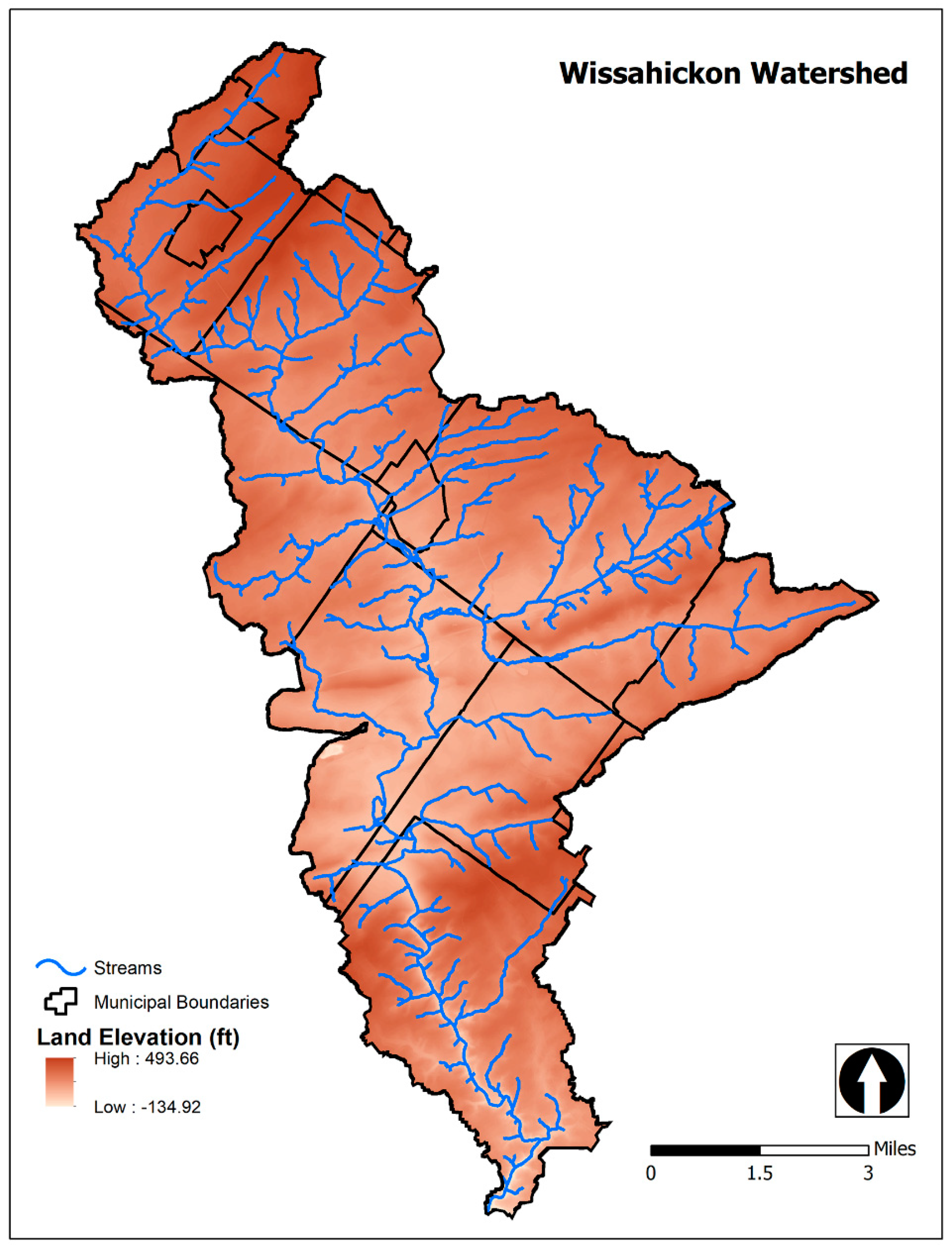
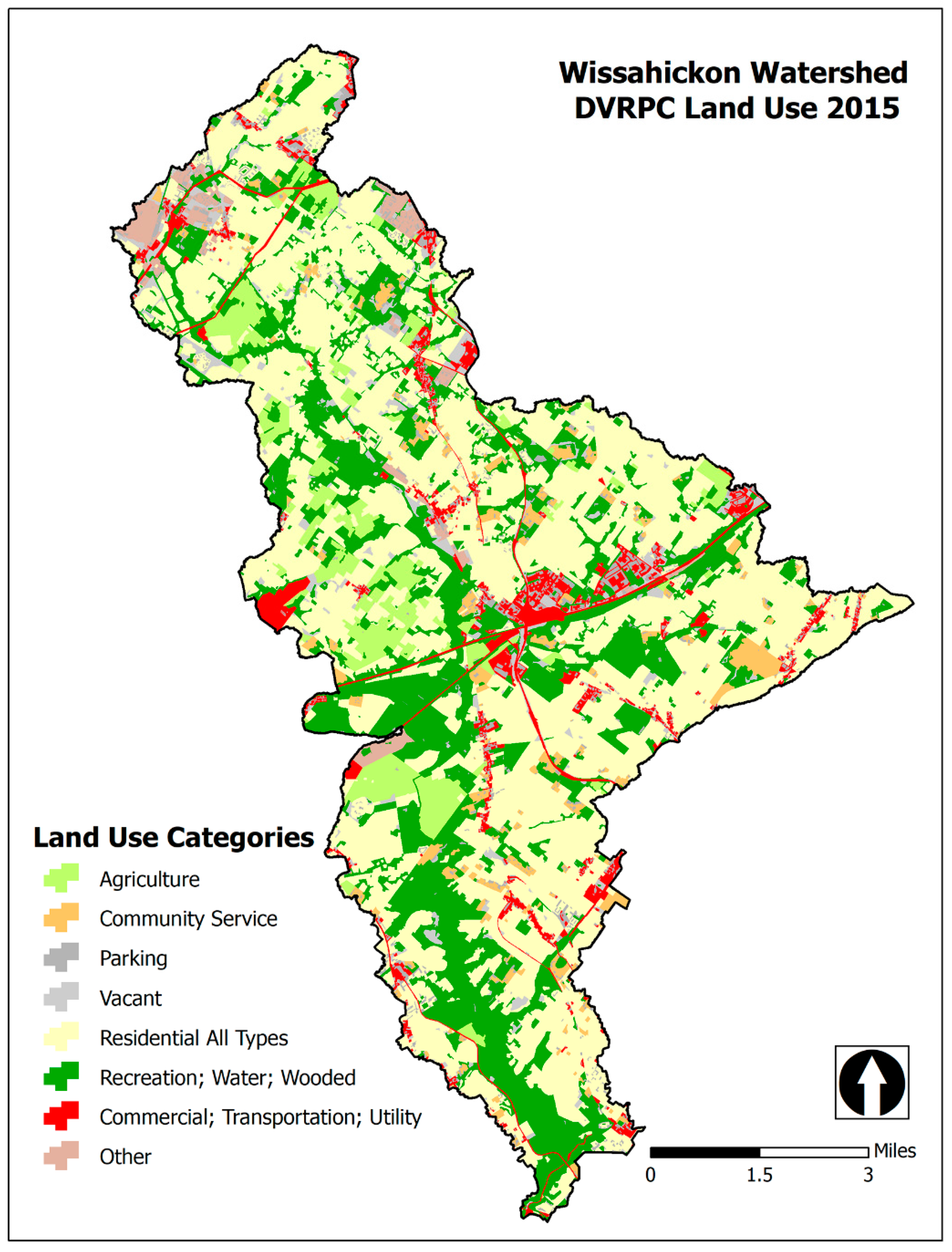
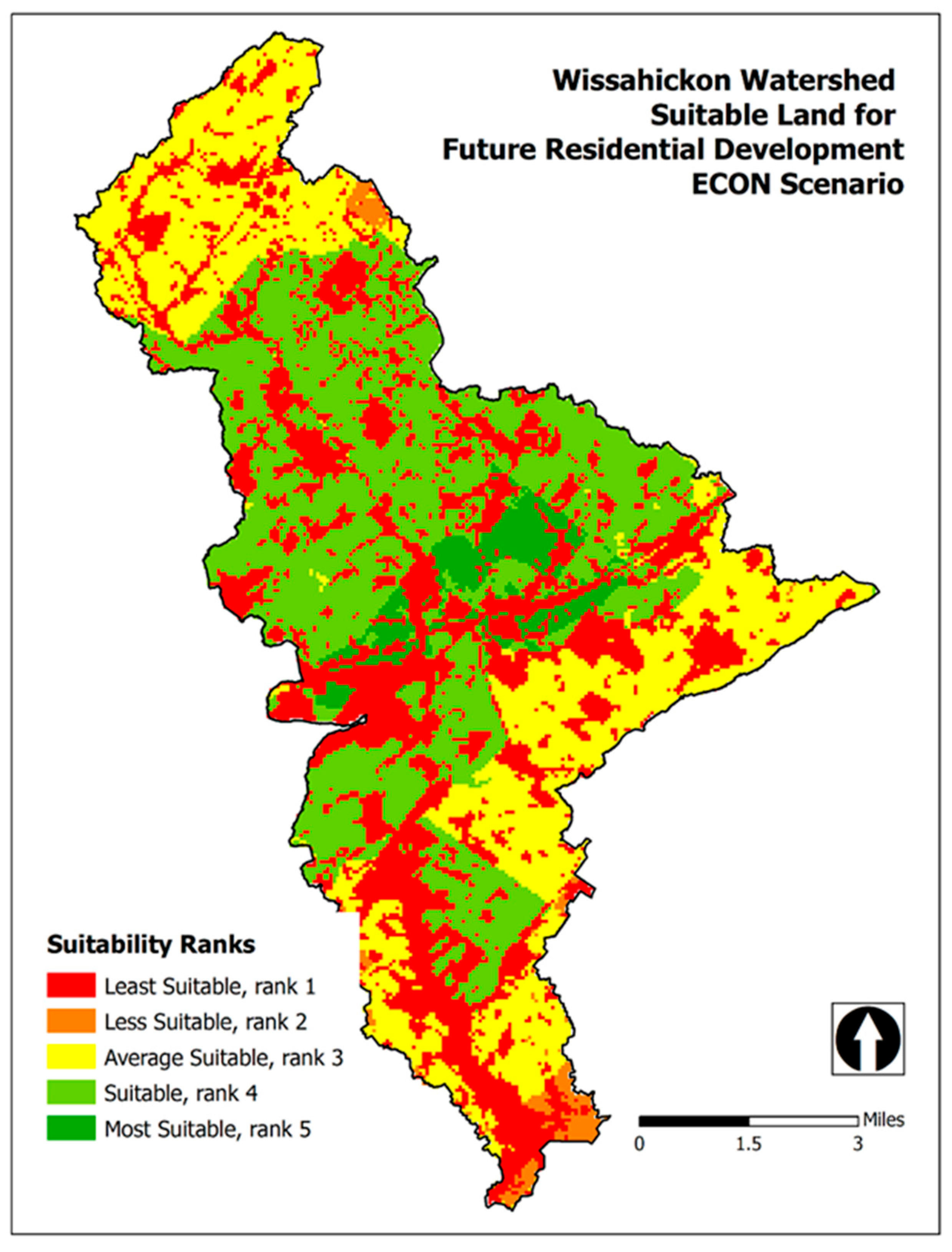
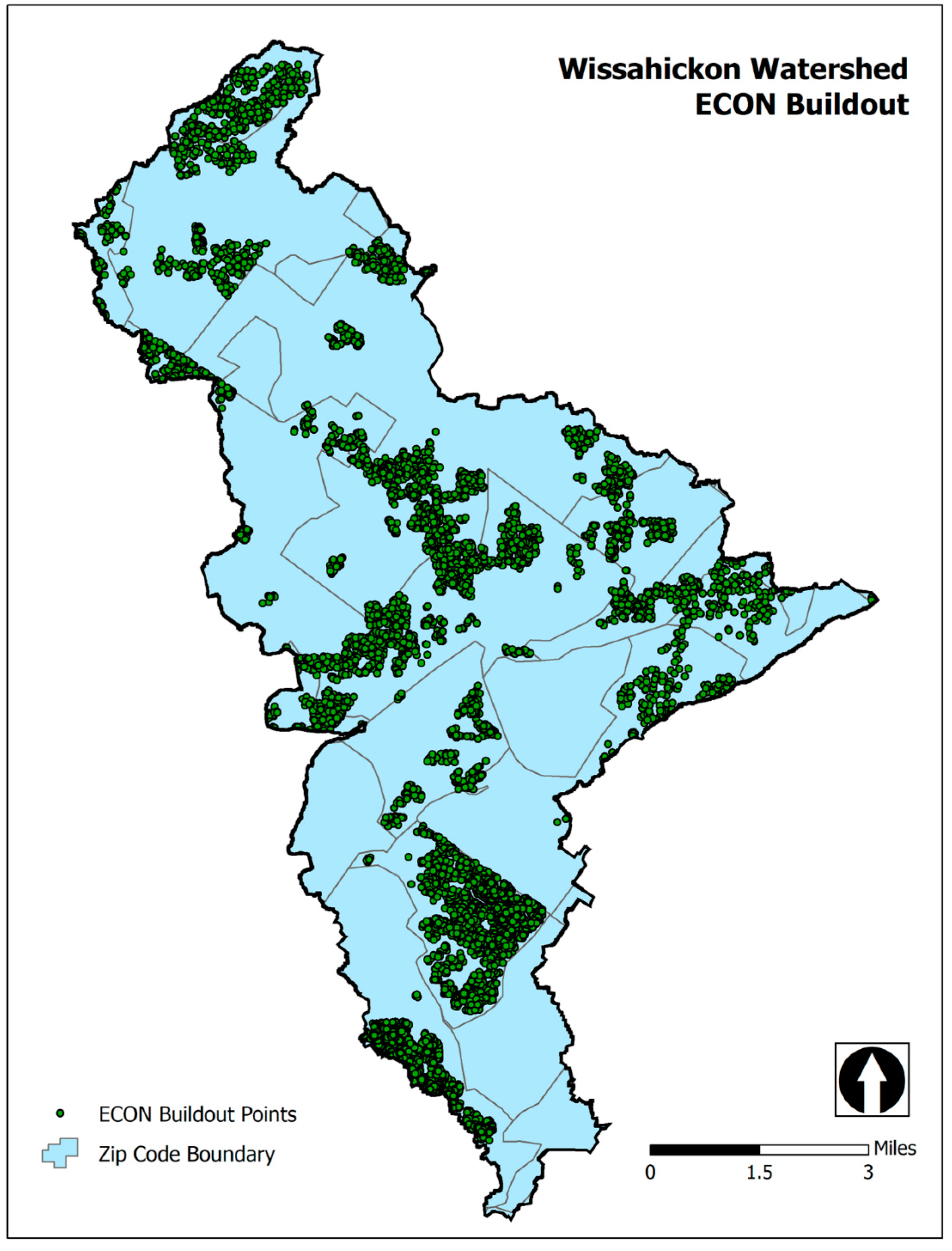
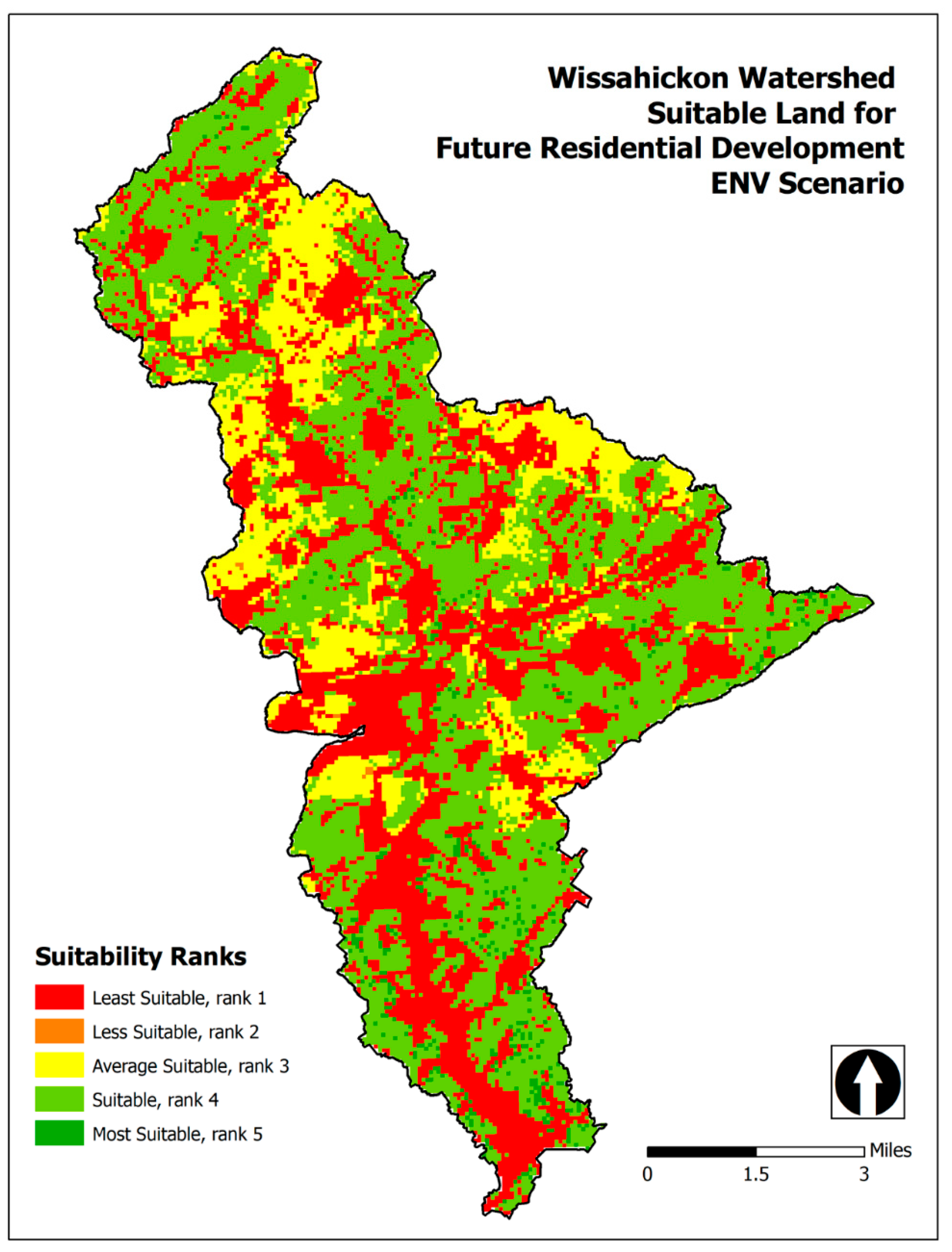
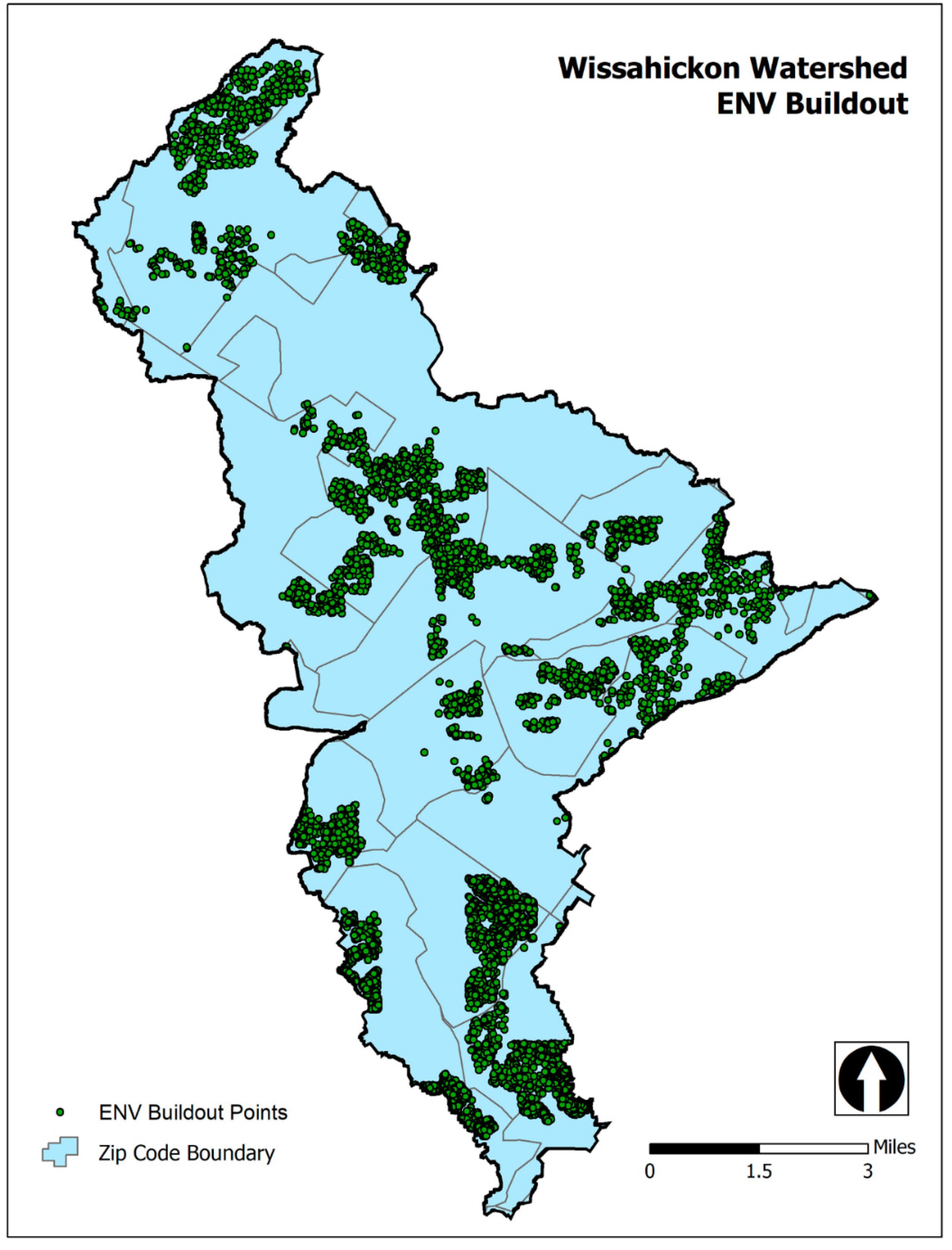

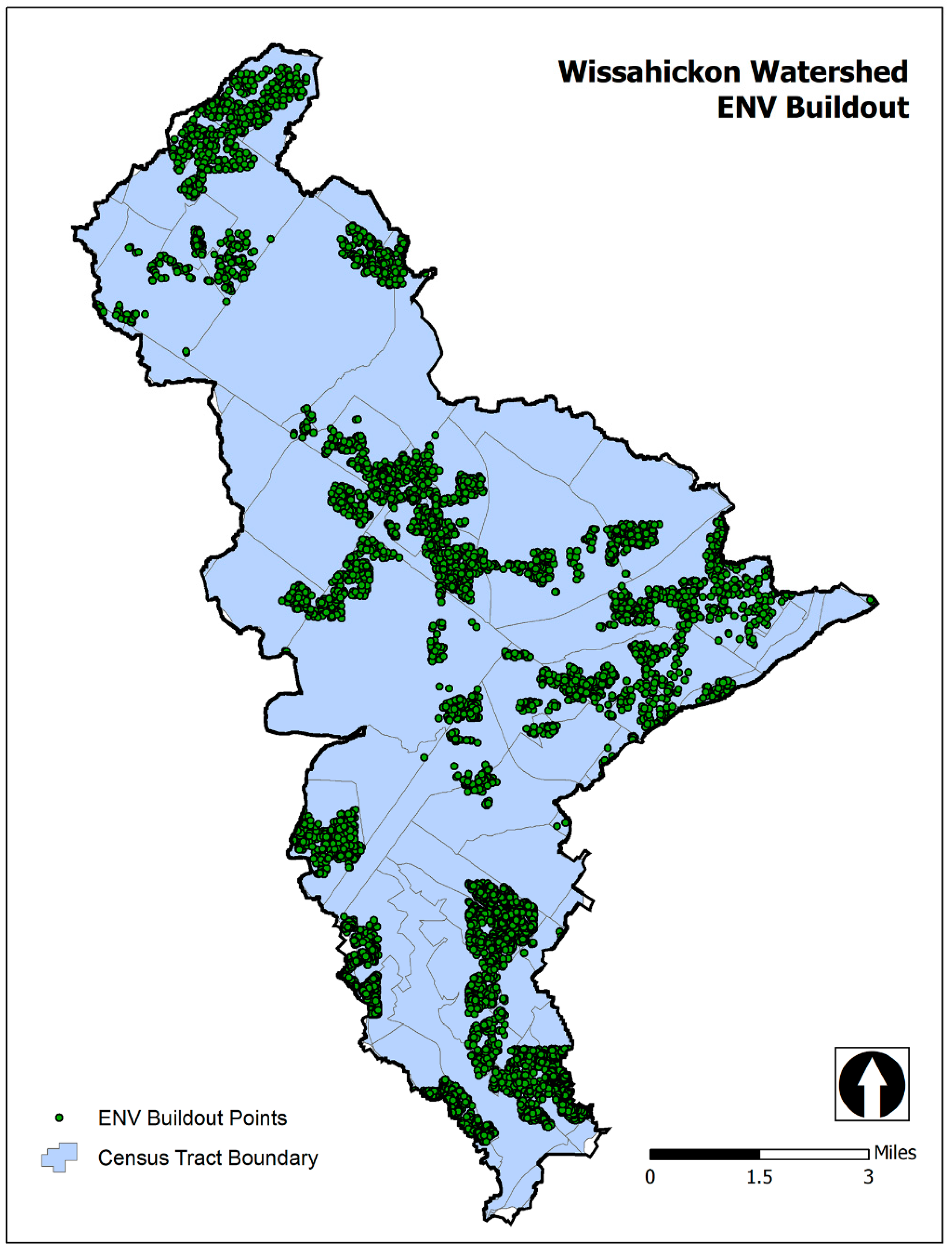
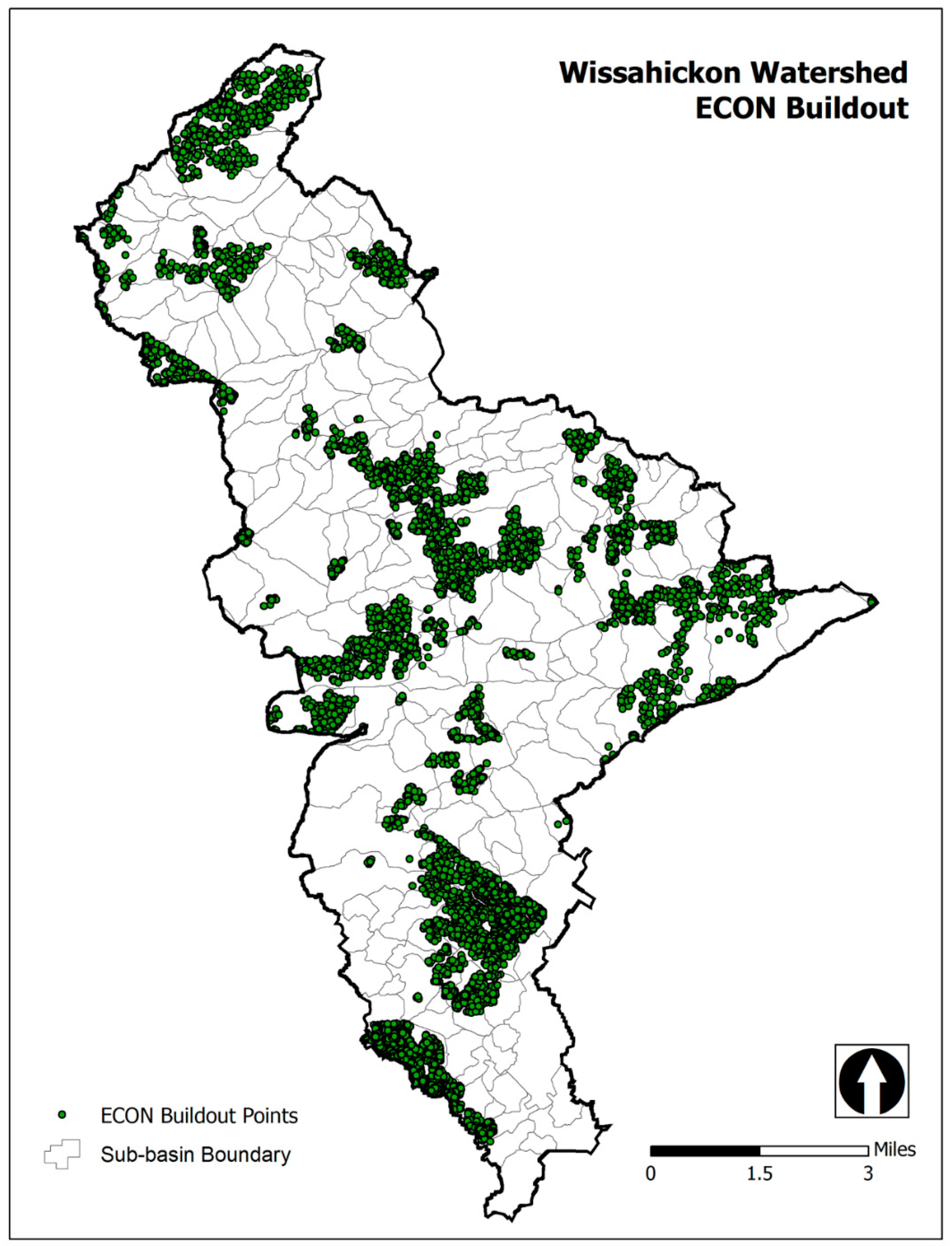
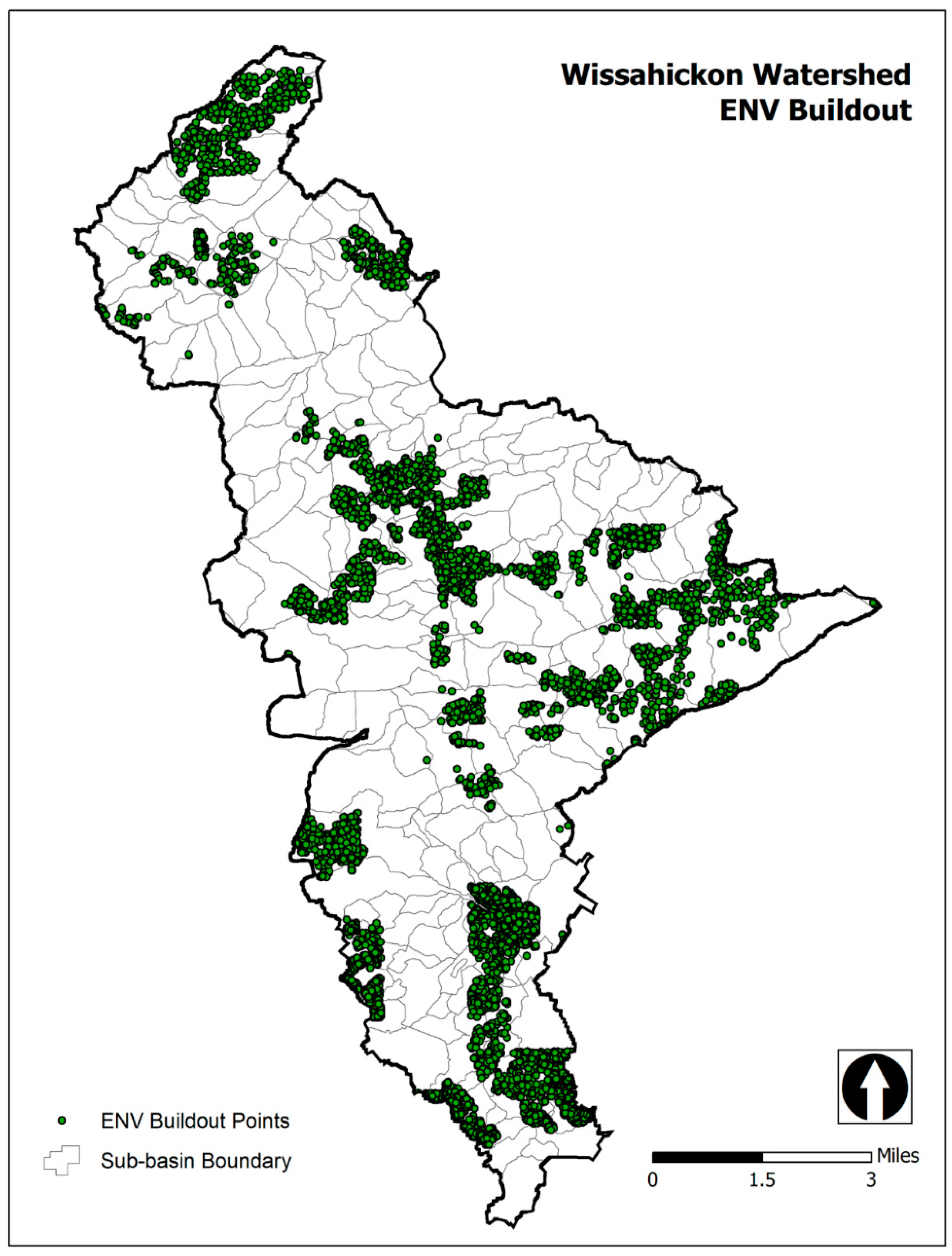
| Municipality | 2015 Pop | 2015–2016 Occupied Units | 2015* Pop/ 2016 Units | 2045 Pop | 2015 to 2045 Pop -Change | Housing Units Needed | % Muni in the WCW | Housing Units Needed in the WCW |
|---|---|---|---|---|---|---|---|---|
| Abington Township | 55,590 | 20,955 | 2.65 | 59,083 | 3493 | 1317 | 0.2294 | 302 |
| Ambler Borough | 6505 | 2644 | 2.46 | 7422 | 917 | 373 | 1 | 373 |
| Cheltenham Township | 37,014 | 14,349 | 2.58 | 39,607 | 2593 | 1005 | 0.0139 | 14 |
| Horsham Township | 26,587 | 9964 | 2.67 | 32,541 | 5954 | 2231 | 0.056 | 125 |
| Lansdale Borough | 16,512 | 6467 | 2.55 | 19,152 | 2640 | 1034 | 0.2365 | 245 |
| Lower Gwynedd Township | 11,548 | 4567 | 2.53 | 12651 | 1103 | 436 | 0.8829 | 385 |
| Montgomery Township | 26,025 | 9255 | 2.81 | 28735 | 2710 | 964 | 0.1401 | 135 |
| North Wales Borough | 3250 | 1342 | 2.42 | 3392 | 142 | 59 | 1 | 59 |
| Springfield Township | 19,574 | 7419 | 2.64 | 20,574 | 1000 | 379 | 0.0734 | 28 |
| Upper Dublin Township | 26,211 | 9441 | 2.78 | 29,745 | 3534 | 1273 | 0.9457 | 1204 |
| Upper Gwynedd Township | 15,928 | 6340 | 2.51 | 17,053 | 1125 | 448 | 0.903 | 405 |
| Upper Moreland Township | 24,231 | 9537 | 2.54 | 25,749 | 1518 | 597 | 0.6186 | 369 |
| Whitemarsh Township | 17,663 | 6710 | 2.63 | 20,476 | 2813 | 1069 | 0.029 | 31 |
| Whitpain Township | 19,180 | 7153 | 2.68 | 20,661 | 1481 | 552 | 0.5638 | 311 |
| Worcester Township | 10,435 | 3720 | 2.81 | 12,943 | 2508 | 894 | 0.4168 | 373 |
| Philadelphia City/County | 1,567,443 | 582,594 | 2.69 | 1,696,133 | 128,690 | 47,832 | 0.064 | 3061 |
| Data | Source | Year of Publication |
|---|---|---|
| Land Use | DVRPC | 2015 |
| Floodplains: 100, 500 years | CSC | 2016 |
| Streams | CSC | 2016 |
| Slope | CSC | 2016 |
| Parks and Open Spaces | DVRPC | 2015 |
| Points of Interests (School, Place of Worship, Hospital/Clinic, Employment Center, College/University) | CSC | 2016 |
| Wetlands | CSC, DVRPC | 2016 |
| Bus Stops | DVRPC | 2015 |
| Train Stations | S.E. Penn. Transportation Authority | 2014 |
| Zip Codes | PA Spatial Data Access/US Census | 2016 |
| House Construction Cost | Means Residential Construction Cost Data | 2018 |
| Housing Prices | Trulia.com | 2018 |
| Average Income Tax Rate | US Internal Revenue Service | 2018 |
| Mortgage Rate | Wall Street Journal | 2018 |
| Zoning ordinances of the 15 municipalities in the WCW | Municipal Web Sites | 2019 |
| Zip Code | Median House Price ($) | ATUC ($) | Common Level Ratio | Full Price/m2 ($) | House Price/m2 ($) | Build Cost/m2 ($) | Profit/m2 ($) |
|---|---|---|---|---|---|---|---|
| 18936 | $232,000.00 | $22,383.97 | 0.6211 | 1790.05 | 1342.54 | 1200.65 | 141.89 |
| 19001 | $256,300.00 | $22,903.66 | 0.6211 | 1872.94 | 1404.70 | 1200.65 | 204.06 |
| 19002 | $411,250.00 | $30,360.64 | 0.6211 | 1891.02 | 1418.26 | 1200.65 | 217.62 |
| 19006 | $353,000.00 | $28,420.19 | 0.6211 | 1758.84 | 1319.13 | 1200.65 | 118.48 |
| 19025 | $353,000.00 | $28,791.55 | 0.6211 | 1750.55 | 1312.91 | 1200.65 | 112.27 |
| 19031 | $300,500.00 | $24,484.02 | 0.6211 | 1922.99 | 1442.24 | 1200.65 | 241.60 |
| 19034 | $475,000.00 | $34,937.43 | 0.6211 | 2020.19 | 1515.14 | 1200.65 | 314.50 |
| 19038 | $230,000.00 | $22,190.97 | 0.6211 | 1881.87 | 1411.40 | 1200.65 | 210.76 |
| 19044 | $214,500.00 | $18,944.40 | 0.6211 | 1740.54 | 1305.40 | 1200.65 | 104.76 |
| 19075 | $242,750.00 | $22,560.24 | 0.6211 | 1834.72 | 1376.04 | 1200.65 | 175.40 |
| 19090 | $200,850.00 | $19,779.38 | 0.6211 | 1609.00 | 1206.75 | 1200.65 | 6.11 |
| 19118 | $452,000.00 | $32,034.64 | 0.3058 | 2271.53 | 1703.65 | 1200.65 | 503.00 |
| 19119 | $233,200.00 | $19,066.74 | 0.3058 | 1311.92 | 983.94 | 1200.65 | –216.71 |
| 19127 | $180,000.00 | $14,214.45 | 0.3058 | 1456.91 | 1092.68 | 1200.65 | –107.97 |
| 19128 | $207,500.00 | $18,126.17 | 0.3058 | 1578.33 | 1183.74 | 1200.65 | –16.90 |
| 19129 | $153,000.00 | $14,706.29 | 0.3058 | 1561.64 | 1171.23 | 1200.65 | –29.41 |
| 19144 | $127,000.00 | $12,907.87 | 0.3058 | 728.51 | 546.38 | 1200.65 | –654.26 |
| 19150 | $128,000.00 | $13,519.67 | 0.3058 | 1025.81 | 769.36 | 1200.65 | –431.29 |
| 19422 | $439,000.00 | $30,817.25 | 0.3058 | 1819.65 | 1364.74 | 1200.65 | 164.10 |
| 19428 | $338,000.00 | $25,912.26 | 0.6211 | 1823.21 | 1367.40 | 1200.65 | 166.76 |
| 19436 | $439,900.00 | $30,249.14 | 0.6211 | 1841.18 | 1380.89 | 1200.65 | 180.24 |
| 19444 | $373,750.00 | $27,693.02 | 0.6211 | 1936.01 | 1452.01 | 1200.65 | 251.36 |
| 19446 | $243,500.00 | $21,592.01 | 0.6211 | 1622.13 | 1216.60 | 1200.65 | 15.96 |
| 19454 | $260,000.00 | $21,370.06 | 0.6211 | 1827.19 | 1370.39 | 1200.65 | 169.75 |
| 19462 | $335,000.00 | $26,221.99 | 0.6211 | 1904.15 | 1428.11 | 1200.65 | 227.47 |
| Zip Code | Educational Attainment | Index of Household Income | Crime Index | School District Name | School District Rating |
|---|---|---|---|---|---|
| 18936 | 13 | 1.81 | 1 | North Penn | 0.748 |
| 19001 | 14.08 | 0.8 | 3 | Abington | 0.826 |
| 19002 | 15.72 | 0.89 | 3 | Wissahickon | 0.931 |
| 19006 | 15.81 | 0.85 | 3 | Lower Moreland | 0.907 |
| 19025 | 17 | 1.33 | 1 | Upper Dublin | 0.924 |
| 19031 | 15.41 | 0.92 | 3 | Colonial | 0.881 |
| 19034 | 16.1 | 1 | 6 | Upper Dublin | 0.924 |
| 19038 | 15.05 | 0.83 | 6 | Cheltenham Township | 0.582 |
| 19044 | 11.14 | 0.81 | 6 | Hatboro-Horsham | 0.665 |
| 19075 | 14.81 | 0.88 | 1 | Springfield Township | 0.787 |
| 19090 | 11.32 | 0.75 | 6 | Upper Moreland | 0.726 |
| 19118 | 17.5 | 0.88 | 10 | Philadelphia | 0.185 |
| 19119 | 14.95 | 0.74 | 10 | Philadelphia | 0.185 |
| 19127 | 14.65 | 0.72 | 10 | Philadelphia | 0.185 |
| 19128 | 14.47 | 0.82 | 10 | Philadelphia | 0.185 |
| 19129 | 14.87 | 0.72 | 10 | Philadelphia | 0.185 |
| 19144 | 12.97 | 0.52 | 10 | Philadelphia | 0.185 |
| 19150 | 12.9 | 0.56 | 10 | Philadelphia | 0.185 |
| 19422 | 16.23 | 1.11 | 10 | Wissahickon | 0.931 |
| 19428 | 14.8 | 0.94 | 6 | Colonial | 0.881 |
| 19436 | 16.48 | 0.92 | 10 | Wissahickon | 0.931 |
| 19437 | 19.11 | 3.44 | 1 | Wissahickon | 0.931 |
| 19444 | 16.12 | 1.09 | 3 | Colonial | 0.881 |
| 19446 | 14.49 | 0.83 | 3 | North Penn | 0.748 |
| 19454 | 14.89 | 0.95 | 3 | North Penn | 0.748 |
| 19462 | 14.7 | 0.89 | 3 | Colonial | 0.881 |
| Impacts of Residential Development | FEGS Category | FEGS via a More Benign Scenario | Beneficiaries | Benefit |
|---|---|---|---|---|
| Stormwater runoff added to baseflow; streambank erosion; nutrient and sediment buildup | Provisioning | Cleaner water supply | Philadelphia Water Dept. and drinking water consumers | Reduced increase in water-treatment costs |
| Auto traffic air and greenhouse emissions; air pollution deposition | Regulation | Higher air pollution mitigation; higher greenhouse gas mitigation; lower deposition | Downwind citizens; downstream citizens; nearby residents | Reduced health problems; reduced property damage |
| Degradation of the local natural environment | Cultural * | Reduced degradation during nature visits | Visitors and nature-lovers | Reduced loss of value |
| Negative feedback loops | Supporting | Natural biological, chemical, and physical cycles | All the above | ??? |
| GREET WTW Run with Vehicle SI ICEV CA Gasoline | ||||||
|---|---|---|---|---|---|---|
| Total ECON | Total ENV | |||||
| Name | WTP | Operation | WTW | Total Units | 405,885 VKT | 394,554 VKT |
| Total Energy (kJ/km) | 704.97 | 2819.25 | 3524.22 | MJ | 1,430,429.50 | 1,390,496.52 |
| Fossil Fuel (kJ/km) | 3286.34 | 0 | 3286.34 | MJ | 1,333,874.25 | 1,296,636.78 |
| Coal Fuel (kJ/km) | 45.67 | 0 | 45.67 | MJ | 18,537.10 | 18,019.60 |
| Natural Gas Fuel (kJ/km) | 439.89 | 0 | 439.89 | MJ | 178,546.54 | 173,562.10 |
| Petroleum Fuel (kJ/km) | 2800.62 | 0 | 2800.62 | MJ | 1,136,730.10 | 1,104,996.26 |
| Renewable (kJ/km) | 229.25 | 0 | 229.25 | MJ | 93,051.03 | 90,453.34 |
| Biomass (kJ/km) | 222.34 | 0 | 222.34 | MJ | 90,242.61 | 87,723.32 |
| Nuclear (kJ/km) | 8.73 | 0 | 8.73 | MJ | 3544.56 | 3445.61 |
| VOC (g/km) | 0.08 | 0.08 | 0.17 | g | 68.07 | 66.17 |
| CO (g/km) | 48.21 | 1.68 | 1.73 | g | 700.84 | 681.28 |
| NOx (g/km) | 0.12 | 0.07 | 0.20 | g | 80.67 | 78.42 |
| PM10 (mg/km) | 12.05 | 3.36 | 15.40 | mg | 6252.14 | 6077.60 |
| PM2.5 (mg/km) | 8.82 | 2.97 | 11.79 | mg | 4784.91 | 4651.33 |
| SOx (g/km) | 0.08 | 0.001 | 0.08 | g | 32.77 | 31.86 |
| CH4 (g/km) | 0.30 | 0.01 | 0.31 | g | 126.05 | 122.53 |
| CO2 (kg/km) | 0.05 | 0.20 | 0.25 | kg | 100.84 | 98.03 |
| N2O (mg/km) | 7.49 | 4.73 | 12.22 | mg | 4958.86 | 4820.42 |
| VOC Urban (g/km) | 0.05 | 0.07 | 0.11 | g | 45.38 | 44.11 |
| CO Urban (g/km) | 0.01 | 1.38 | 1.39 | g | 562.19 | 546.49 |
| NOx Urban (g/km) | 0.02 | 0.06 | 0.08 | g | 32.77 | 31.86 |
| PM10 Urban (mg/km) | 3.36 | 2.75 | 6.11 | mg | 2480.69 | 2411.44 |
| PM2.5 Urban (mg/km) | 2.72 | 2.43 | 5.16 | mg | 2092.45 | 2034.04 |
| SOx Urban (mg/km) | 20.99 | 1.00 | 21.99 | mg | 8924.43 | 8675.29 |
| CH4 Urban (mg/km) | 8.80 | 4.40 | 13.20 | mg | 5357.18 | 5207.62 |
| CO2 Urban (kg/km) | 0.03 | 0.17 | 0.19 | kg | 78.15 | 75.97 |
| N2O Urban (mg/km) | 0.30 | 3.88 | 4.18 | mg | 1696.65 | 1649.28 |
| Station | WQI (add) | WQI (mult) | IBI |
|---|---|---|---|
| WS2041 | 73.57 | 69.38 | * |
| WS1850 | 58.43 | 52.42 | 23.16 |
| WS1371 | * | * | 24.84 |
| WS1317 | 69.38 | 67.66 | * |
| WS1140 | 62.32 | 56.12 | 26.27 |
| WS1075 | 71.55 | 63.21 | 21.21 |
| WS754 | 61.9 | 57.19 | 20.17 |
| WS405 | 64.4 | 60.69 | 17.75 |
| WS076 | 71 | 38.39 | 20.17 |
| WS005 | 80.82 | 34.95 | 17.75 |
| Station | %-ECON Bldgs | %-ENV Bldgs | WWQI (add) ECON | WWQI (add) ENV | WWQI (mult) ECON | WWQI (mult) ENV | WIBI ECON | WIBI ENV |
|---|---|---|---|---|---|---|---|---|
| WS2041 | 0.078 | 0.082 | 5.72 | 6.04 | 5.39 | 5.70 | * | * |
| WS1850 | 0.036 | 0.027 | 2.11 | 1.60 | 1.89 | 1.44 | 0.84 | 0.64 |
| WS1371 | 0.060 | 0.059 | * | * | * | * | 1.50 | 1.46 |
| WS1317 | 0.040 | 0.041 | 2.80 | 2.87 | 2.73 | 2.80 | * | * |
| WS1140 | 0.087 | 0.100 | 5.40 | 6.25 | 4.86 | 5.63 | 2.28 | 2.63 |
| WS1075 | 0.116 | 0.079 | 8.32 | 5.62 | 7.35 | 4.96 | 2.47 | 1.67 |
| WS754 | 0.124 | 0.134 | 7.70 | 8.31 | 7.12 | 7.67 | 2.51 | 2.71 |
| WS405 | 0.231 | 0.220 | 14.88 | 14.15 | 14.03 | 13.33 | 4.10 | 3.90 |
| WS076 | 0.227 | 0.257 | 16.13 | 18.22 | 8.72 | 9.85 | 4.58 | 5.18 |
| Total | 1.000 | 0.999 | 63.05 | 63.05 | 52.08 | 51.38 | 18.27 | 18.18 |
| Indicator | ECON | ENV | Assessment | ECON-ENV |
|---|---|---|---|---|
| WPSM($) | 22.23 | 10.82 | Higher is better | 11.41 |
| TVKT * | 405,885 | 394,554 | Lower is better | 11,331 |
| WWQIadd | 63.052 | 63.054 | Higher is better | −0.002 |
| WWQImult | 52.08 | 51.38 | Higher is better | 0.70 |
| WIBI | 18.18 | 18.27 | Higher is better | −0.09 |
© 2019 by the authors. Licensee MDPI, Basel, Switzerland. This article is an open access article distributed under the terms and conditions of the Creative Commons Attribution (CC BY) license (http://creativecommons.org/licenses/by/4.0/).
Share and Cite
Sorrentino, J.; Meenar, M.; Wargo, D. Residential Land Use Change in the Wissahickon Creek Watershed: Profitability and Sustainability? Sustainability 2019, 11, 5933. https://doi.org/10.3390/su11215933
Sorrentino J, Meenar M, Wargo D. Residential Land Use Change in the Wissahickon Creek Watershed: Profitability and Sustainability? Sustainability. 2019; 11(21):5933. https://doi.org/10.3390/su11215933
Chicago/Turabian StyleSorrentino, John, Mahbubur Meenar, and Donald Wargo. 2019. "Residential Land Use Change in the Wissahickon Creek Watershed: Profitability and Sustainability?" Sustainability 11, no. 21: 5933. https://doi.org/10.3390/su11215933
APA StyleSorrentino, J., Meenar, M., & Wargo, D. (2019). Residential Land Use Change in the Wissahickon Creek Watershed: Profitability and Sustainability? Sustainability, 11(21), 5933. https://doi.org/10.3390/su11215933






